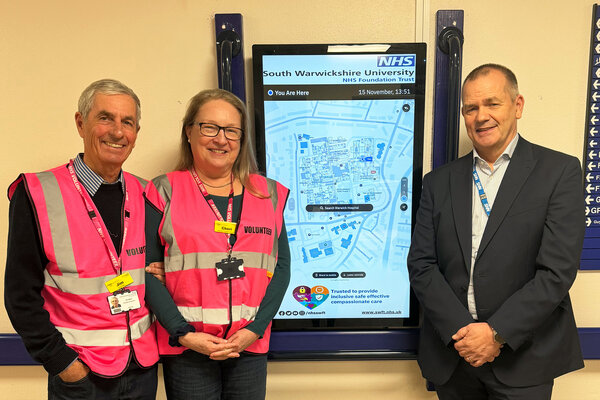Blog Series: Making Healthcare More Accessible For Patients With Disabilities Using Digital Wayfinding.

Summary:
The problem
Statistics
Using smart technology for improved accessibility
How Living Map's Dynamic, Digital Wayfinding helps patients with mobility impairments
In today’s world of advancing smart technologies, healthcare is increasingly becoming more efficient, yet many individuals with disabilities still face significant challenges when accessing the care they need. Ironically, it is these individuals who often have the highest need for consistent medical attention, but they are the most underserved when it comes to navigating large hospitals and medical centres. Despite the importance of their access, many healthcare facilities are still built around the needs of people without disabilities, creating significant obstacles for those with mobility impairments.
Recent studies highlight this issue. Rhea Horlock, Head of Corporate Social Responsibility at NHS Property Services, noted that nearly half of disabled individuals have either struggled to access medical facilities or been entirely unable to do so. Even more troubling, 78% of those who did manage to access healthcare services reported experiencing difficulties during their visit. These figures are alarming, especially when considering the already stressful circumstances under which many disabled individuals live. Accessing healthcare should alleviate stress, not compound it. Unfortunately, the design and infrastructure of many medical centres fail to account for the needs of this exposed population.
The problem often starts as soon as disabled individuals arrive at the hospital. Many hospitals are designed without the consideration of people with mobility impairments creating a maze of obstacles such as navigating stairs, locating elevators, or finding accessible routes. For individuals who use wheelchairs or those with visual impairments, this experience can be daunting and exhausting. Large hospitals, with their complex layouts and lack of clear accessibility features, can turn what should be a straightforward visit into a frustrating ordeal.
With the growing awareness of this issue, there is a pressing need for healthcare facilities to prioritise accessibility. And while traditional solutions, such as additional signage or staff to assist with navigation, have been tried, they are simply not enough to meet the growing needs of disabled individuals. This is where smart technology can make a real difference.
Smart technology offers the opportunity to dramatically improve healthcare accessibility for disabled individuals. At Living Map, we have developed a digital wayfinding platform that addresses these challenges head-on. Our innovative platform is designed to provide clear, accessible navigation for all users, particularly those with disabilities, ensuring that every individual can move through a healthcare facility with ease.
Our wayfinding solution provides seamless navigation, offering real-time directions that are easy to follow. The platform is intuitive, so even those who may not be familiar with technology can use it without difficulty. This ensures that patients can navigate large medical centres without confusion, reducing stress and saving valuable time. For disabled individuals, our system offers a specific feature that allows for stepless navigation. This means that wheelchair users or those with other mobility issues can avoid stairs and steep ramps and instead follow routes that have been specifically designed to accommodate their needs. This feature can significantly enhance the healthcare experience for those who would otherwise face physical barriers. Moreover, the system is constantly updated in real time, ensuring that patients are not directed to areas that may be temporarily closed or inaccessible due to maintenance or other issues. This dynamic feature allows for seamless navigation, ensuring that patients always have access to the most accurate information.
Beyond simple navigation, our platform integrates with the broader medical system, making it easy for patients to find specific clinics, doctors’ offices, or treatment areas. This not only enhances the user experience but also improves the overall efficiency of healthcare facilities, as patients can reach their destinations more quickly and with less assistance from staff.
The benefits of smart technology in healthcare extend beyond convenience. It’s about ensuring that everyone, regardless of their physical abilities, has equal access to medical care. For disabled individuals, accessing healthcare has too often been a source of frustration and stress, when it should be something that improves their quality of life. By leveraging smart technologies like our wayfinding platform, we can remove the physical barriers that have historically prevented these individuals from getting the care they need.
Accessibility is not just about removing barriers; it’s about creating a healthcare environment that is truly inclusive. Our wayfinding solution is just one example of how smart technology can be used to improve accessibility for disabled individuals. As healthcare continues to evolve, smart technologies will play an even greater role in ensuring that everyone can access the services they need. Smart technologies are not just a convenience—they are a necessity in ensuring that healthcare is accessible to everyone.
* (2023) NHS Property Services. Available at: https://www.property.nhs.uk/news/blogs/why-accessibility-matters-when-it-comes-to-the-healthcare-estate/#:~:text=In%20the%20Government's%20UK%20Disability,experienced%20at%20least%20some%20difficulties (Accessed: 25 September 2024).
Request a demo
Experience the power of our mapping, wayfinding, and asset tracking technology for yourself. See how our software can enhance your facility.






